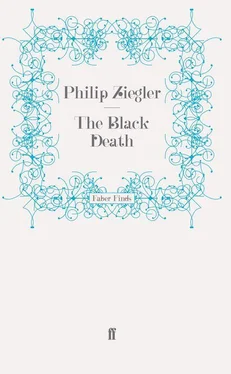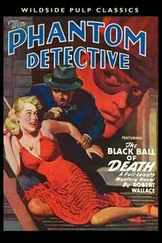• Allyn, H. M. ‘The Black Death. Its Social and Economic Results’, Annals of Medical History, Vol. VII, 1925, p. 226.
• Baehrel, M. ‘Épidémie et Terreur: histoire et sociologie’, Annales Hist de la Rev. Fran., XXIII, 1951, p. 113.
• Baehrel, M. ‘La Haine de Classe en temps d’épidémie’, Annales E.S.C, VII, 1952, No. 2, p. 351.
• Bean, J. M. W. ‘Plague, Population and Economic Decline in England in the Later Middle Ages’, Econ. Hist. Rev., 2nd Series, Vol. XV, 1963, p. 423.
• Beresford, M. The Lost Villages of England, London, 1954.
• Campbell, A.* The Black Death and Men of Learning, New York, 1931. Crawfurd, R. Plague and Pestilence in Literature and Art, Oxford, 1914.
• Cohn, N.* The Pursuit of the Millennium, London, 1957.
• D’Irsay, S. ‘The Black Death and the Mediaeval Universities’, Annals of Medical History, Vol. VII, 1925, p. 220.
• D’Irsay, S. ‘Notes to the Origin of the Expression: Atra Mors’, Isis, Vol. 8, 1926, p. 328.
• D’Irsay, S.* ‘Defence Reactions during the Black Death’, Annals of Medical History, Vol. IX, 1927, p. 169.
• Febvre, L. ‘La Peste Noire de 1348’, Annales E.S.C, IV, 1949, No. 1, p. 102.
• Gray, H. L. ‘The Commutation of Villein Services in England before the Black Death’, Eng. Hist. Rev., Vol. XXIX, 1914, p. 625.
• Guerchberg, S. ‘La Controverse sur les Prétendus Semeurs de la Peste Noire d’après les traités de peste de l’époque’, Revue des Études Juives, Vol. 8, 1948, p.3.
• Hare, R. Pomp and Pestilence, London, 1954.
• Holmes, G. A. The Estates of the Higher Nobility in Fourteenth Century England, Cambridge, 1957.
• Hoskins, W. G. The Making of the English Landscape, London, 1955.
• Jeanselme, M. E. ‘Inondations, Famines et Tremblements de Terre sont les avant-coureurs de la Peste’, Proc. 3rd Int. Cong. Hist. Med., 1923.
• Kelter, E.* ‘Das Deutsche Wirtschaftsleben des 14 und 15 Jahrhunderts im Schatten der Pestepidemien’, Jahrbürcher für Nationalökonomie und Statistik ’, Vol. 165, 1953, p. 161.
• Kjennerud, I. R. ‘Black Death’, Journ. Hist. Med., Vol. 3, 1948. p. 359.
• Kosminsky, E. A Studies in the Agrarian History of England in the 13th Century, Oxford, 1956.
• Langer, W. L.* ‘The Next Assignment’, American Hist. Rev., Vol. LXIII, 1958 No. 2, p. 283.
• Lutge, F. ‘Das 14/15 Jahrhundert in der Sozial und Wirtschaftsgeschichte’, Jahrbücher für Nationalökonomie und Statistik, Vol. 161, 1950, p. 161.
• Meiss, M.* Painting in Florence and Siena after the Black Death, Princeton, 1951.
• Michon, L. A. J.* ‘Documents inédits sur la Grande Peste de 1348’, Theses de l’Écolede Médicine, Vol. VI, Paris, 1860.
• Mode, P. Influence of the Black Death on English Monasteries, Chicago, 1916 .
• Mollaret, H. H. and Brossolet, J. La Peste, Source Méconnue d’Inspiration Artistique, Paris (Institut Pasteur), 1965.
• Page, T. W. ‘The End of Villainage in England’, Pub. Amer. Econ.Assoc., Third Series, 1900, Vol. I.
• Parkes, J. The Jew in the Mediaeval Community, London, 1938.
• Perdrizet, P. La Peinturereligieuse en Italic jusqu’ à la findu XIVe Siècle, Nancy, 1905. Perdrizet, P. La Viergede Miséricorde, Paris, 1908.
• Postan, M.* ‘Some Economic Evidence of Declining Population in the Later Middle Ages’, Econ. Hist. Rev., 2nd Ser., Vol. II, 1950, p. 221.
• Power, E. ‘The Effects of the Black Death on Rural Organization in England’, History, N.S., Vol. III, 1918, p. 109.
• Putnam, B. H. The Enforcement of the Statute of Labourers, New York, 1908.
• Renouard, Y.* ‘Conséquences et intérêt démographique de la Peste Noire de 1348’, Population, III, 1948, p. 459.
• Réville, A. Le Soulèvement des travailleurs d’Angleterre en 1381, introduction by C. Petit-Dutaillis, Paris, 1898.
• Robbins, H. ‘A Comparison of the Effects of the Black Death on the Economic Organization of France and England’, Journal of Political Economy, Vol. XXXVI, 1928, p. 447.
• Roberts, R. S. ‘The Place of Plague in English History’, Proc. Roy. Soc. Med. ( Hist. Med ), Vol. 59, 1966, p. 101.
• Russell, J. C.* British Mediaeval Population, Albuquerque, 1948.
• Russell, J. S. ‘Effects of Pestilence and Plague, 1315–85’, Comparative Studies in Society and History, Vol. VIII, 1966, No. 4, p. 464.
• Saltmarsh, J. ‘Plague and Economic Decline in England in the Later Middle Ages’, Camb. Hist. Journ., Vol. VII, 1941, No. 1, p. 23.
• Siegfried, A. Itinéraines des contagions: épidémies et idéologies, Paris, 1960.
• Thompson, J. W ‘The Aftermath of the Black Death and the Aftermath of the Great War’, American journal of Sociology, 1920/21, Vol. XXVI.
• Thrupp, S. L. ‘The Problem of Replacement Rates in Late Mediaeval English Population’, Econ. Hist. Rev., 2nd Series, Vol. XVIII, 1965, p. 101.
• Thrupp, S. L. ‘Plague Effects in Mediaeval Europe’, Comparative Studies in Society and History, Vol. VIII, 1966, No. 4, p. 482.
• Titow, J. Z. ‘Some Evidence of the 13th Century Population Increase’, Econ. Hist. Rev., 2nd Series, Vol. XIV, 1961, No. 2, p. 218.
• Tononi, A. G. ‘La Peste dell’ Anno 1348’, Giornale Ligustico, Genoa, Vol. X, 1883, p. 139.
• Wilson, E. M. Carus Mediaeval Merchant Venturers, London, 1954.
The most important contemporary or near-contemporary texts, listed under the country of the chronicler, are as follows:
Italy
• Cronica Senese di Agnolo di Tura del Grasso, Muratori, Return ItalicarumScriptores, 15, VI, pp.555–7.
• Storie Pistoresi, Muratori, 11, V, pp.23 5–8.
• Gabriel de Mussis, Historia de Morbo s . Mortalitate quae fuit Anno Dni MCCCXLVII, ed. Henschel; Haeser’s Archiv, für die Gesammte Medizin, II, 1842, pp.26–59 (cf. V. J. Derbes, ‘De Mussis and the Great Plague of 1348’, J.A.M.A., Vol. 196, 1966, No. 1.)
• Chronicon Estense, Muratori, 15, III, pp. 159–64.
• Michael Platiensis, Bibliotheca Scriptorum Qui Res In Sicilia Gestas Retulere, Vol. 1, p. 562.
• Lorenzo de Monaci, Chronicon de Rebus Venetorum, Venice, 1758.
• Peter Azarius, Muratori, XVI, p. 16.
• Cronica Florentine di Marchionne di Coppo Stefani, Muratori, 30, I.
• Cronica de Giovanni Villani, ed. Dragomanni, Florence, 1845.
• Cronica di Matteo Villani, ed. Dragomanni, Florence, 1846.
• Monumenta Pisana, Muratori, XV (1729 edition), p.1021.
• Cronicon Gestorum ac Factorum Memorabilium civitatis Bononie, Muratori, 28, III, p. 43.
Germany
• Matthaie Neuwenburgensis, Cronica, Fontes Rerum Germanicarum (F.R.G.), ed. Boehmer, Stuttgart, 1868, pp. 261–7; cf. Mon. Germ. Hist., N.S., Vol. IV, Berlin, 1936.
• Henricus Dapifer de Diessenhoven, F.R.G., Stuttgart, 1868, IV, pp. 68–71.
• Hugh von Reutlingen, Weltchronik, ed. Gillert, Munich, 1881.
• Johannis de Winterthur (Vitodurani), Mon. Germ. Hist., N.S., Vol. III.
• Annales Engelbergenses, Mon. Germ. Hist., XVII.
• Kalendarium Zwetlense, Mon. Germ. Hist., IX.
Читать дальше












